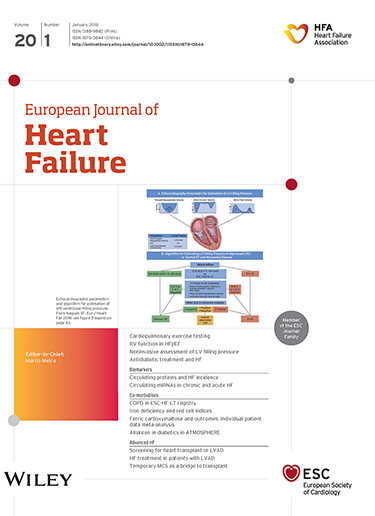Deep phenotyping of heart failure with preserved ejection fraction through multi-omics integration.
IF 10.8
1区 医学
Q1 CARDIAC & CARDIOVASCULAR SYSTEMS
引用次数: 0
Abstract
AIMS Heart failure with preserved ejection fraction (HFpEF) has become the predominant form of heart failure and a leading cause of global cardiovascular morbidity and mortality. Due to its heterogeneous nature, HFpEF presents substantial challenges in diagnosis and management. Given the limited treatment options and lifestyle-associated comorbidities, early identification is crucial for establishing effective preventive strategies. Here, we introduce and validate a machine learning-based multi-omics approach that integrates clinical and molecular data to detect and characterize HFpEF. METHODS AND RESULTS A supervised classifier was trained on a stratified subset of UK Biobank participants (n = 401 917) to identify phenotypic profiles associated with subsequent symptom-defined HFpEF during longitudinal follow-up. Model performance was validated in a non-overlapping hold-out subset from all 22 UK Biobank assessment centres (n = 100 446; 6726 HFpEF cases; 7394 with multi-omics data). The classifier demonstrated robust discriminatory performance, with a receiver operating characteristic area under the curve (ROC AUC) of 0.931 (95% confidence interval [CI] 0.930-0.931), a sensitivity of 0.857 (95% CI 0.855-0.860) and a specificity of 0.847 (95% CI 0.846-0.847). It identified individuals who subsequently developed HFpEF an average of 6.3 ± 3.9 years before symptom onset in asymptomatic individuals. Similarity network fusion (SNF) identified distinct subgroups, including a high-risk cluster characterized by elevated mortality and dysregulated inflammatory pathways, which was distinguishable with high accuracy (ROC AUC 0.988; 95% CI 0.985-0.990). CONCLUSIONS We identified HFpEF phenotypes at an early stage, often several years before the onset of clinical symptoms, when the disease trajectory may still be amenable to modification. The molecular characterization provides novel insights into the underlying disease complexity and enables more refined risk stratification.通过多组学整合保留射血分数的心力衰竭深度表型。
保留射血分数的心力衰竭(HFpEF)已成为心力衰竭的主要形式,也是全球心血管疾病发病率和死亡率的主要原因。由于其异质性,HFpEF在诊断和管理方面提出了重大挑战。鉴于有限的治疗选择和与生活方式相关的合并症,早期识别对于制定有效的预防策略至关重要。在这里,我们介绍并验证了一种基于机器学习的多组学方法,该方法整合了临床和分子数据来检测和表征HFpEF。方法和结果在英国生物银行参与者的分层子集(n = 401 917)上训练sa监督分类器,以在纵向随访期间识别与随后症状定义的HFpEF相关的表型谱。在来自所有22个UK Biobank评估中心的非重叠保留子集中验证了模型的性能(n = 100 446; 6726例HFpEF病例;7394例多组学数据)。分类器表现出稳健的判别性能,受试者曲线下工作特征面积(ROC AUC)为0.931(95%置信区间[CI] 0.930-0.931),灵敏度为0.857 (95% CI 0.855-0.860),特异性为0.847 (95% CI 0.846-0.847)。该研究确定了在无症状个体出现症状前平均6.3±3.9年出现HFpEF的个体。相似网络融合(SNF)识别出不同的亚群,包括以死亡率升高和炎症通路失调为特征的高风险聚类,其区分准确率很高(ROC AUC 0.988; 95% CI 0.985-0.990)。结论:我们在早期阶段就发现了HFpEF的表型,通常在临床症状出现前几年,此时疾病轨迹可能仍然可以改变。分子表征提供了对潜在疾病复杂性的新见解,并使更精细的风险分层成为可能。
本文章由计算机程序翻译,如有差异,请以英文原文为准。
求助全文
约1分钟内获得全文
求助全文
来源期刊

European Journal of Heart Failure
医学-心血管系统
CiteScore
27.30
自引率
11.50%
发文量
365
审稿时长
1 months
期刊介绍:
European Journal of Heart Failure is an international journal dedicated to advancing knowledge in the field of heart failure management. The journal publishes reviews and editorials aimed at improving understanding, prevention, investigation, and treatment of heart failure. It covers various disciplines such as molecular and cellular biology, pathology, physiology, electrophysiology, pharmacology, clinical sciences, social sciences, and population sciences. The journal welcomes submissions of manuscripts on basic, clinical, and population sciences, as well as original contributions on nursing, care of the elderly, primary care, health economics, and other related specialist fields. It is published monthly and has a readership that includes cardiologists, emergency room physicians, intensivists, internists, general physicians, cardiac nurses, diabetologists, epidemiologists, basic scientists focusing on cardiovascular research, and those working in rehabilitation. The journal is abstracted and indexed in various databases such as Academic Search, Embase, MEDLINE/PubMed, and Science Citation Index.
 求助内容:
求助内容: 应助结果提醒方式:
应助结果提醒方式:


